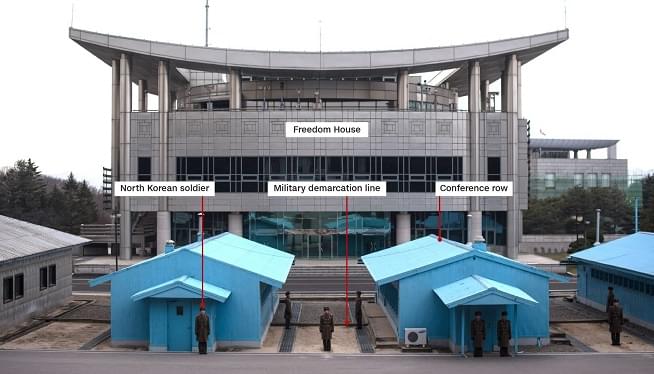SEOUL — It’s been billed as an historic encounter that could lead to peace on the Korean Peninsula, which has been divided for more than six decades.
On Friday morning, North Korean leader Kim Jong Un will be greeted by South Korean President Moon Jae-in at the demilitarized zone (DMZ) that divides the two countries — the first time leaders of the two countries have met since 2007.
The outcome will set the stage for what’s primed to be the most significant diplomatic summit in a generation, with Kim and US President Donald Trump set to meet in May or early June.
Here’s what you need to know.
What’s going to happen?
Kim will walk across the painted Military Demarcation Line (MDL) and into the southern half of the DMZ at about 9.30 a.m. local time Friday morning (8.30 p.m. ET Thursday) — a moment that’s expected to be beamed live to millions worldwide.
There, he will be met by President Moon and together they will make the short walk to the Peace House, a conference center in Panmunjon or Truce Village, which straddles the DMZ.
There’s speculation that Kim will be accompanied by his wife Ri Sol Ju, who traveled with Kim to Beijing last month on his first trip abroad since taking power in 2011.
South Korea has spared no effort in its preparations for the highly choreographed summit, giving the room where they’ll meet a complete makeover, with symbolic design features.
After a break for lunch, Kim and Moon will plant a pine tree using soil from Mount Halla in South Korea and Mount Baekdu in the North. The day will be capped by a multi-course banquet featuring a menu with specialties from North and South.
[van id=”world/2018/04/23/south-korea-propaganda-speaker-hancocks-sot.cnn”]
What’s likely to be achieved?
There’s three key topics on the agenda: the denuclearization of the Korean Peninsula, the improvement of bilateral relations, and a formal peace settlement — the Korean War ended in 1953 with a ceasefire so technically the two sides are still at war.
The highest-stake issue is North Korea’s nuclear weapons program. Kim has conducted more missile tests than either his father or grandfather and claims to have a long-range missile that can reach the US mainland tipped with a nuclear warhead.
Last week, President Moon said North Korea had dropped a long-held demand that the US withdraw its forces stationed in South Korea in exchange for denuclearization, and on Saturday Kim said it no longer needed to test its weapons capability.
But analysts greeted these apparent concessions with skepticism, saying that denuclearization is likely to be a major sticking point in talks and it’s unlikely that Kim will truly consider giving up his weapons.
And even if North Korea agreed to denuclearize, we don’t know how many nuclear weapons it has or where they are located.
Who else is involved?
It’s not just about the two Koreas. China and the US were involved in the Korean War and would likely have to be party to any peace treaty.
For the United States, the inter-Korean summit will act as a barometer for what many consider the main event: a meeting between Kim and Trump. What’s agreed on Friday will chart a course for that encounter and give a better feel for Kim’s agenda.
Japan and China also have a lot at stake in these negotiations.
Tokyo is fearful it’s been left out and is worried that a deal could be struck that would allow North Korea to retain short-and-medium range missile that can target Japan.
Beijing, meanwhile, is worried that Kim is moving out of its orbit and the summit could result in a deal that pushes North Korea closer to the US and its allies.
Keeping China on board will be key, as it could easily derail US and South Korea-led efforts to denuclearize North Korea by lifting sanctions against the North — that analysts say have been a key reason for bring Kim to the table.
Why should I care?
Just months ago, the US and North Korea appeared to be on the brink of war, with Trump promising “fire and fury” and Kim threatening to launch a missile at the US territory of Guam.
Any military confrontation on the Korean Peninsula would expose South Korea and Japan to devastating casualties and put the US homeland at risk of North Korean missiles.
The diplomatic rapprochement that has unfolded this year makes this much less likely — an achievement in itself.
In addition to security, there are hopes that any deal with Kim could benefit ordinary North Koreans, many of whom are thought to suffer from malnutrition. However, North Korea’s dire human rights situation is not expected to be a major topic of discussion.
How did we get here?
No-one knows for sure why Kim decided to come to the negotiating table but analysts say it’s likely a combination of three factors.
Economic pressure and sanctions have begun to bite, making Kim vulnerable economically. Trade with China, the country’s traditional ally and economic benefactor, has collapsed.
Kim craves international recognition and believes his nuclear weapons give him strength and leverage on the world stage and at home. He wants foreign leaders to treat him as an equal not a pariah. Sitting down for a summit with Moon, and then Trump, will be characterized as a victory back home that neither his father nor grandfather was able to achieve.
Lastly, Kim could be playing for time. Trump’s first term in office has been marked by erratic threats, military displays and the appointment of hardliners to key Cabinet positions. Calculating that the risk of war has risen, Kim may think talks are necessary to ensure the survival of his family dynasty.
The-CNN-Wire™ & © 2018 Cable News Network, Inc., a Time Warner Company. All rights reserved. (PHOTO: CNN)






















